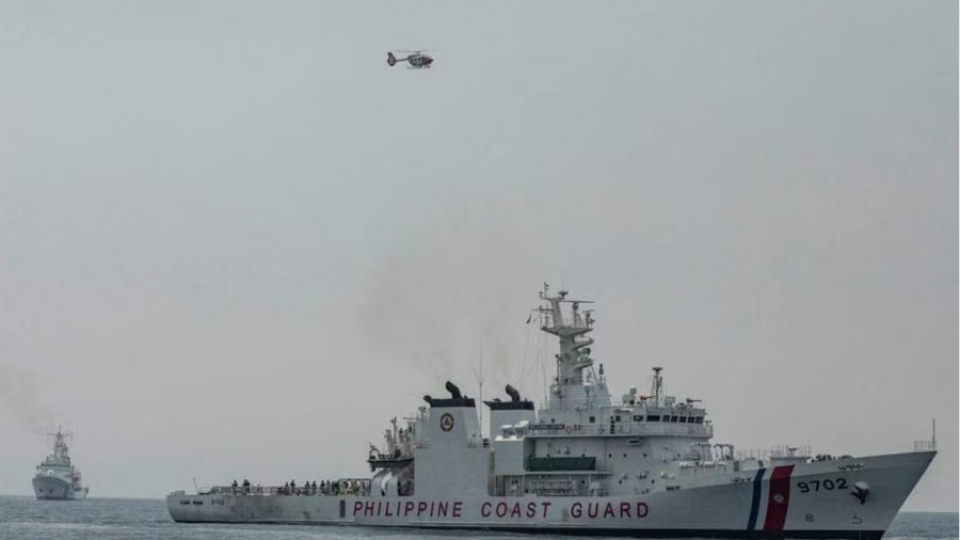June 7, 2023
BATAAN – The Philippines on Tuesday “neutralised” a simulated terrorist threat off the coast of Bataan province in the South China Sea as part of its first coast guard drills with defence allies United States and Japan, amid tensions with China.
Philippine Coast Guard (PCG) personnel boarded a patrol vessel marked as a mock enemy vessel, “MV Destroyer”, to intercept four crew members with links to an international terrorist group.
The PCG was tasked to stop the MV Destroyer, which was carrying “weapons of mass destruction”, from entering the country’s ports.
Journalists watching the drills from another PCG ship heard the shooting of blank bullets ring out in the disputed waters as Filipino coast guard officers boarded the MV Destroyer to pursue their targets.
Vessels from the US Coast Guard (USCG) and the Japan Coast Guard (JCG) were on standby as they received radio updates about the operation from a PCG officer.
Minutes later, PCG personnel were seen arresting four of the MV Destroyer’s crew on the deck.
The USCG’s Stratton cutter vessel and the JCG’s Akitsushima vessel went into action after five other crew members jumped overboard, signalling the start of the search-and-rescue part of the trilateral exercises.
The crew members were rescued by USCG and JCG personnel in rubber boats.
Referred to as “Kaagapay”, or “shoulder to shoulder” in Tagalog, the trilateral drills are the first of their kind between the Philippines, the US and Japan, with Australia acting as an observer.
They kicked off last Thursday and will run until Wednesday, with almost 500 coast guard personnel from the three countries taking part.
The exercises are being conducted 15 nautical miles off the coast of Bataan, an area that lies well within the 200-nautical-mile exclusive economic zone of the Philippines in the South China Sea. Manila officially calls these waters the West Philippine Sea.
WATCH: About 15 nautical miles off the coast of Bataan in the South China Sea, the Philippine Coast Guard “neutralized” terrorists aboard a mock enemy vessel with weapons of mass destruction in its first joint drills with the US and Japan. @straits_times pic.twitter.com/YgtSydeI15
— Mara Cepeda (@maracepeda) June 6, 2023
In 2016, an arbitral tribunal ruled that the area belongs to the Philippines, but China has refused to recognise the decision.
Beijing has ramped up its military aggression in the disputed waterway, prompting Philippine President Ferdinand Marcos Jr to bolster security and defence ties with allies such as the US, Japan and Australia to help counter Beijing’s growing influence in the region.
There are also ongoing talks between the four countries on holding joint coast guard patrols in the South China Sea.
PCG assistant spokesman Jherich Ybanez told reporters that the Kaagapay drills were not necessarily meant to deter Beijing.
“This is purely coast guard to coast guard. Again, these exercises are being done to build the relationship that we have with partners that we already had before.
“We hope that these exercises will increase our relationship with them so that our coast guard will get better, stronger.
“And, of course, we will have a little bit more cooperation among the coast guards of these three nations.”

Coast guard leaders of (from left) Japan, Captain Toru Imai; the Philippines, Captain Antonio Sontillanosa; and the US, Captain Brian Krautler, linking arms during a welcome ceremony at the Port of Manila last Thursday for their trilateral maritime drills. PHOTO: EPA-EFE
Geopolitical analyst Don McLain Gill of the Philippine-Middle East Studies Association said the Kaagapay drills illustrate the growing convergence of three like-minded and democratic countries in the Indo-Pacific.
“The diverse scenarios incorporated in the drills, such as the mock terrorist vessel encounter, also reflect the recognition by all three countries of the need to adapt to the deepening and broadening traditional and non-traditional security threats in the Western Pacific,” said Mr Gill.
“This multifaceted outlook also indicates that all three countries recognise each other’s importance in tackling the various threats that plague the region.”
The Straits Times has contacted the Chinese Embassy in Manila for comment on the Kaagapay exercises, but it has yet to respond.

